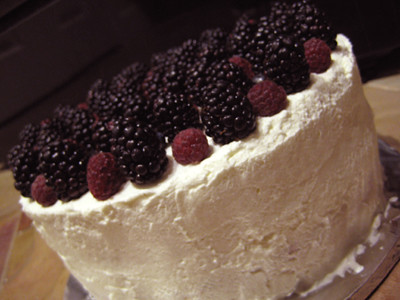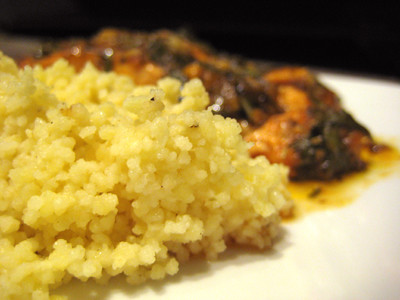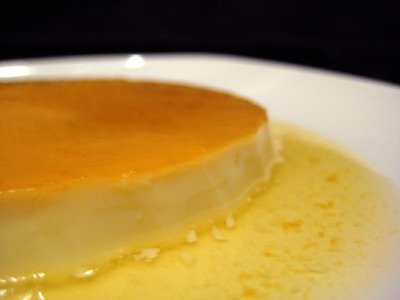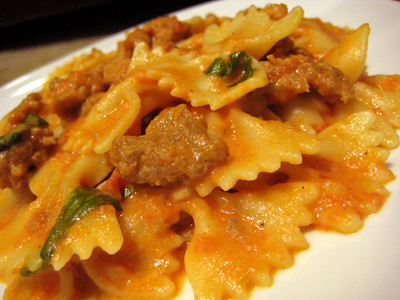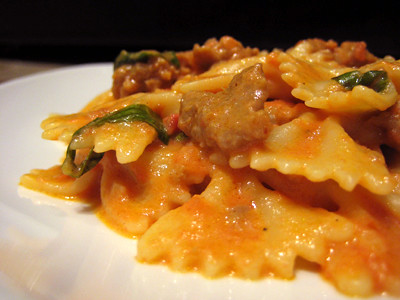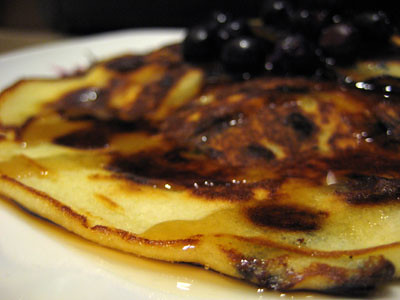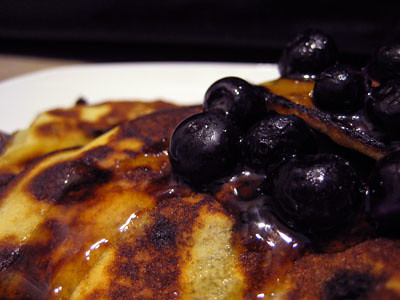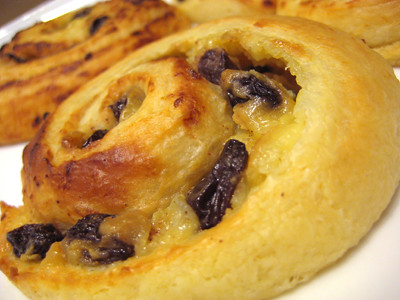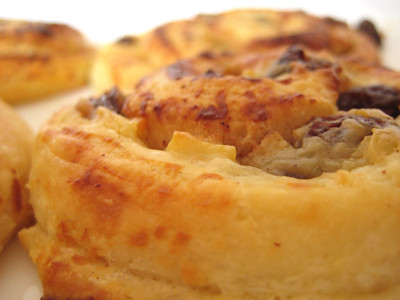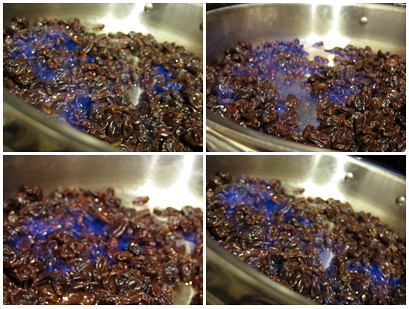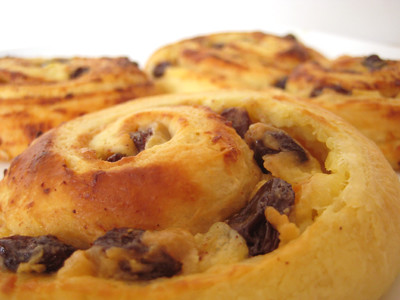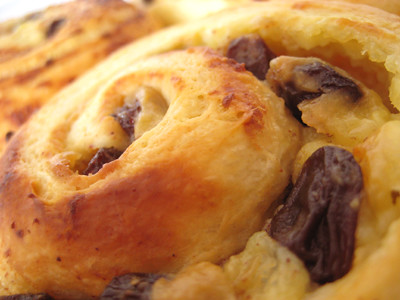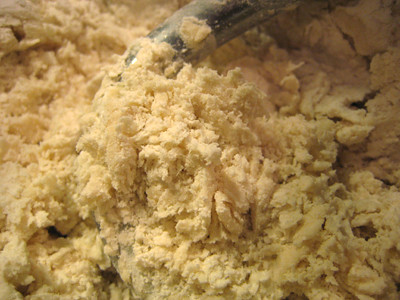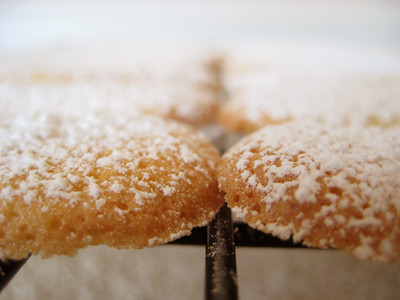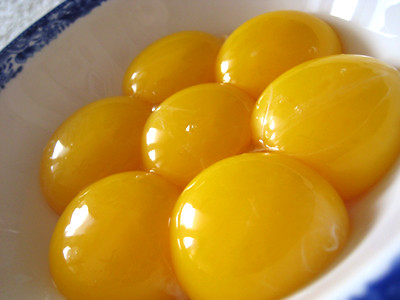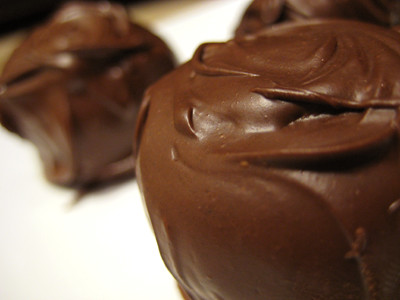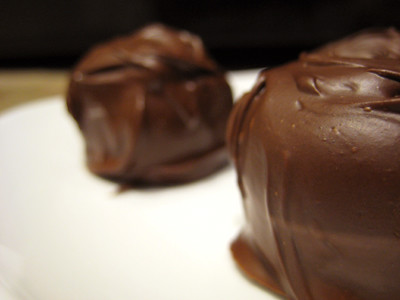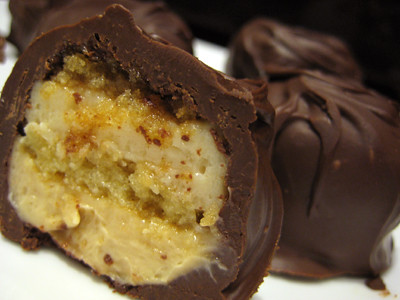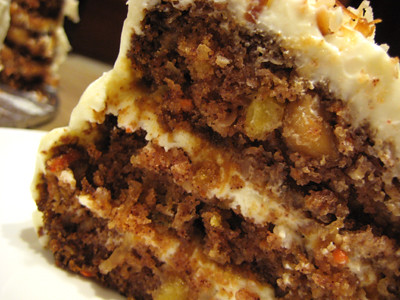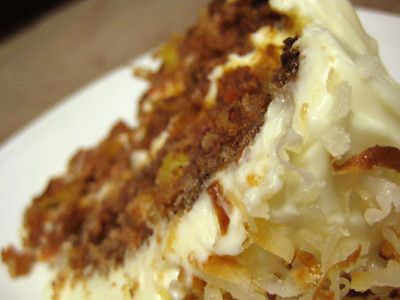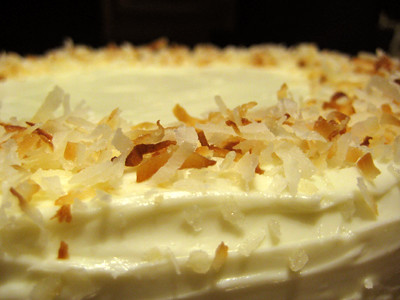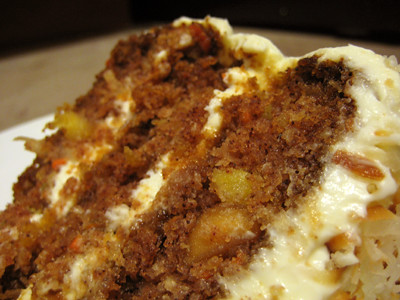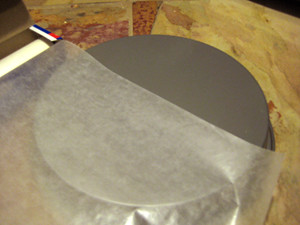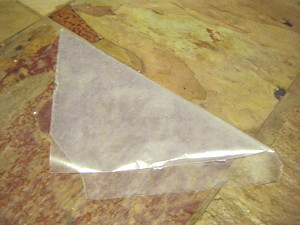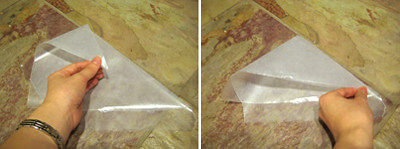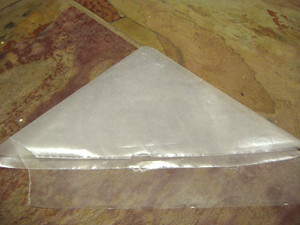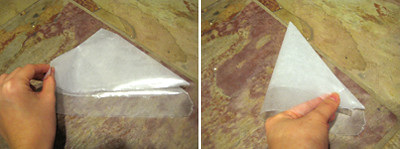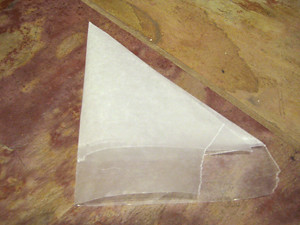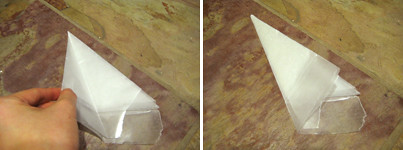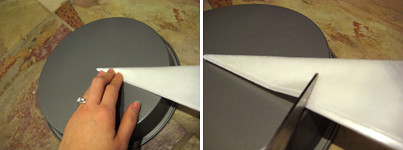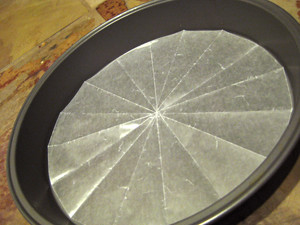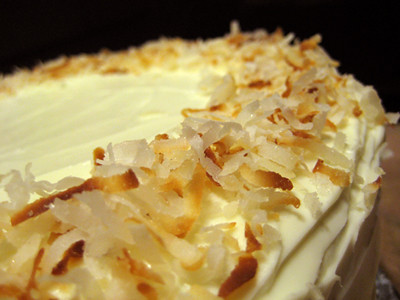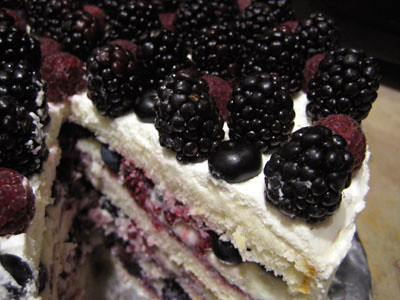
When I found out that this month's challenge, chosen by Morven of Food Art and Random Thoughts, was going to be Dorie's Perfect Party Cake, I breathed a huge sigh of relief. You see, last month was my very first Daring Baker's challenge... and Julia Child's French Bread was quite the challenge for me! I had never made French Bread before, I hardly had any of the equipment required for the recipe, and I was still learning how to work with yeast. So when I saw that we were going to make a simple layer cake this month, I was thrilled :) Now granted, I am still very new to the world of layer cakes, but the only challenging thing I find about making them is how to cut the layers evenly so you don't end up with a lopsided cake (*Tip: use toothpicks to mark your cake and then cut it). Otherwise, they're pretty straight forward.
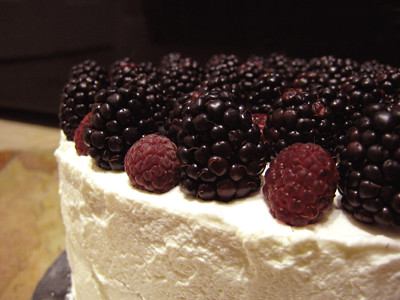
I also knew that the cake itself would not disappoint, as every recipe I have made from Dorie's book, Baking: From My Home to Yours, has been wonderful. If you don't believe me, just check out all the great things we've baked up over at Tuesdays with Dorie! TWD is a group of foodies who pick one recipe from Dorie's book to bake each week; the recipe is then posted on everyone's blogs on Tuesday. If you're a Dorie fan and haven't joined us yet, head on over to the TWD blog to sign up.
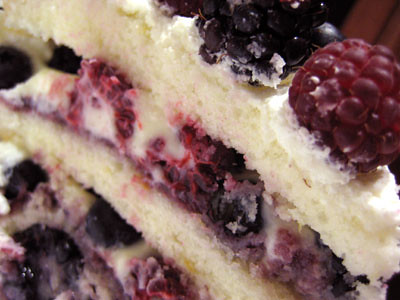
Ok, so enough about TWD. Back to the DB challenge. I was even more excited to read that Morven had given us free reign over this recipe to "play around with it," as Dorie calls it, and personalize it to our own tastes. Not a buttercream fan? Just use sweetened whipped cream instead. Don't like raspberries? Use any other type of berry preserve you'd prefer. Enjoy fresh fruit in your cakes? Then go ahead and add them... you can add them just between each cake layer, or on top as well!
It seems that several DBers had problems with their cakes not rising enough to cut them in half in order to create the four layers. I'm not sure if that was because some did not use cake flour, but I had no such problems. Initially, when I removed them from the pans, I wasn't sure if they were thick enough to cut in half, but I went ahead and tried and they turned out ok. I'm not sure exactly how much the cake is supposed to rise, but I think my layers were about the same thickness as the ones depicted in the book.
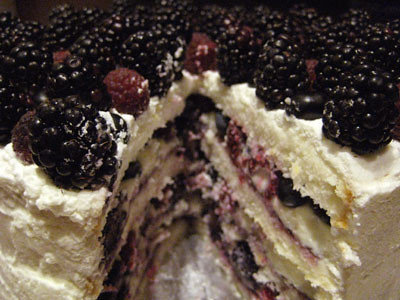
I'm not a big fan of buttercream (it isn't very good for you anyway - 3 sticks of butter?!), so I decided to use white chocolate whipped cream (from Dorie's Black and White Cake) between the cake layers and firmly whipped sweetened cream to frost the top and sides of the cake. Instead of raspberry preserves, I used Forest Berry Favorit Swiss Preserves (raspberries, blueberries, blackberries, cranberries, and strawberries). I also added fresh fruit (raspberries, blueberries, and blackberries) between each cake layer and on top of my cake. My blackberries were a bit on the larger side, so next time I think I will slice them in half before adding them in between the cake layers.

This cake was delicious and truly perfect! I thought the lemon flavor in the cake was subtle, but nice. It had a fairly dense crumb, but was super moist and not too heavy. The fresh berries really made this cake what it was. I just don't think it would be as impressive if it was just preserves and cream. My only regret was that I only had one slice before it was devoured by everyone else! This is definitely a cake that I will make again.
I can't wait to see how everyone else's rendition of this Perfect Party Cake turned out. Be sure to visit the Daring Baker's blogroll to see all the beautiful cakes created this month!
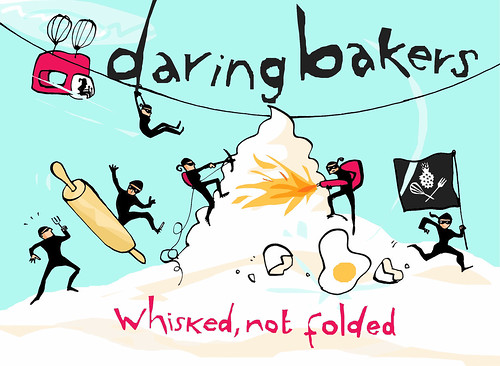
I'm also submitting this to Tasty Tools. This month's tool is the microplane. It's perfect for zesting fruit for recipes like this. I used to do this the old fashioned way by very carefully peeling my fruit and mincing the peels into a fine zest - it is so much faster and easier with the microplane! If you don't have one yet, I highly suggest that you invest in this tasty tool. I also use it for grating cinnamon, nutmeg, chocolate, ginger, and cheese :) And here's a tip - whenever you have some fruit, use your microplane to zest it and then store your zest in airtight container or ziploc baggy in the freezer. That way, you can have some on hand whenever a recipe calls for it!
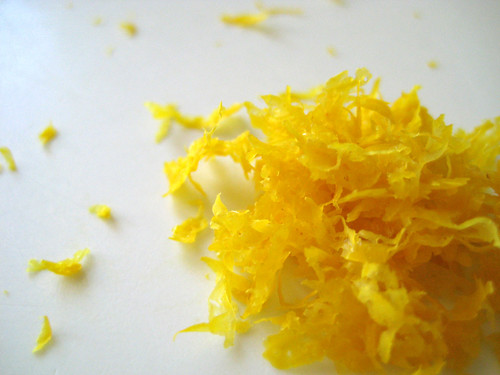
Perfect Party Cake
from Baking: From My Home to Yours, by Dorie Greenspan (p. 250)
For the Cake
2 ½ cups cake flour
1 tablespoon baking powder
½ teaspoon salt
1 ¼ cups whole milk or buttermilk (I prefer buttermilk with the lemon) (Dorie also recommends having this at room temperature)
4 large egg whites (Dorie recommends having these at room temperature)
1 ½ cups sugar
2 teaspoons grated lemon zest
1 stick (8 tablespoons or 4 ounces) unsalted butter, at room temperature
½ teaspoon pure lemon extract
For the Buttercream
1 cup sugar
4 large egg whites
3 sticks (12 ounces) unsalted butter, at room temperature
¼ cup fresh lemon juice (from 2 large lemons)
1 teaspoon pure vanilla extract
(I used Dorie's white chocolate whipped cream recipe + 1 cup heavy cream whipped up with some sugar)
For Finishing
2/3 cup seedless raspberry preserves stirred vigorously or warmed gently until spreadable (I used Forest Berry preserves)
About 1 ½ cups sweetened shredded coconut (I omitted this)
About 3/4 cup fresh blueberries
About 1-1/2 cups fresh raspberries
About 2-1/2 cups fresh blackberries
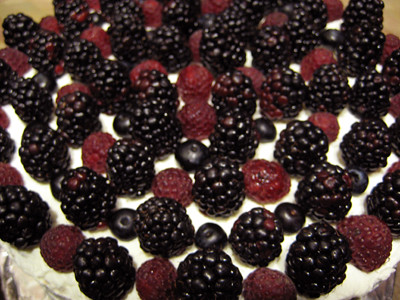
Getting Ready
Center a rack in the oven and preheat the oven to 350°F. Butter two 9 x 2 inch round cake pans and line the bottom of each pan with a round of buttered parchment or wax paper. Put the pans on a baking sheet.
To Make the Cake
Sift together the flour, baking powder and salt.
Whisk together the milk and egg whites in a medium bowl.
Put the sugar and lemon zest in a mixer bowl or another large bowl and rub them together with your fingers until the sugar is moist and fragrant. Add the butter and working with the paddle or whisk attachment, or with a hand mixer, beat at medium speed for a full 3 minutes, until the butter and sugar are very light. Beat in the extract, then add one third of the flour mixture, still beating on medium speed. Beat in half of the milk-egg mixture, then beat in half of the remaining dry ingredients until incorporated. Add the rest of the milk and eggs beating until the batter is homogeneous, then add the last of the dry ingredients. Finally, give the batter a good 2- minute beating to ensure that it is thoroughly mixed and well aerated. Divide the batter between the two pans and smooth the tops with a rubber spatula.
Bake for 30-35 minutes, or until the cakes are well risen and springy to the touch – a thin knife inserted into the centers should come out clean. Transfer the cakes to cooling racks and cool for about 5 minutes, then run a knife around the sides of the cakes, unfold them and peel off the paper liners. Invert and cool to room temperature, right side up (the cooled cake layers can be wrapped airtight and stored at room temperature overnight or frozen for up to two months).
To Make the Buttercream
Put the sugar and egg whites in a mixer bowl or another large heatproof bowl, fit the bowl over a plan of simmering water and whisk constantly, keeping the mixture over the heat, until it feels hot to the touch, about 3 minutes. The sugar should be dissolved, and the mixture will look like shiny marshmallow cream. Remove the bowl from the heat.
Working with the whisk attachment or with a hand mixer, beat the meringue on medium speed until it is cool, about 5 minutes. Switch to the paddle attachment if you have one, and add the butter a stick at a time, beating until smooth. Once all the butter is in, beat in the buttercream on medium-high speed until it is thick and very smooth, 6-10 minutes. During this time the buttercream may curdle or separate – just keep beating and it will come together again. On medium speed, gradually beat in the lemon juice, waiting until each addition is absorbed before adding more, and then the vanilla. You should have a shiny smooth, velvety, pristine white buttercream. Press a piece of plastic against the surface of the buttercream and set aside briefly.
To Assemble the Cake
Using a sharp serrated knife and a gentle sawing motion, slice each layer horizontally in half.
Put one layer cut side up on a cardboard cake round or a cake plate protected by strips of wax or parchment paper. Spread it with one third of the preserves. Cover the jam evenly with about one quarter of the buttercream. (I used white chocolate whipped cream instead of buttercream; I also added a layer of fresh berries on top of the whipped cream here.)
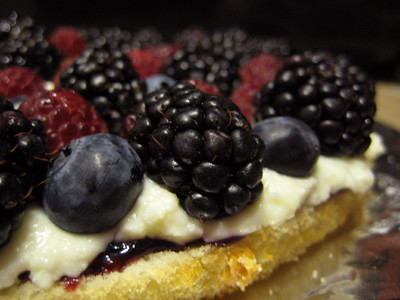
Top with another layer, spread with preserves and buttercream (For me it was more preserves, whipped cream, and berries).


Place the last layer cut side down on top of the cake and use the remaining buttercream to frost the sides and top. Press the coconut into the frosting, patting it gently all over the sides and top.
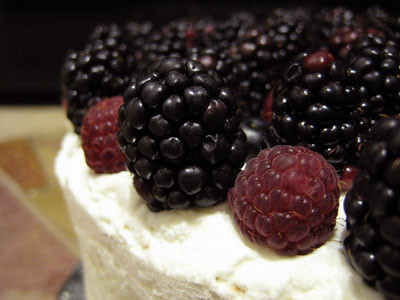
Serving
The cake is ready to serve as soon as it is assembled, but I think it’s best to let it sit and set for a couple of hours in a cool room – not the refrigerator. Whether you wait or slice and enjoy it immediately, the cake should be served at room temperature; it loses all its subtlety when it’s cold. Depending on your audience you can serve the cake with just about anything from milk to sweet or bubbly wine.
Storing
The cake is best the day it is made, but you can refrigerate it, well covered, for up to two days. Bring it to room temperature before serving. If you want to freeze the cake, slide it into the freezer to set, then wrap it really well – it will keep for up to 2 months in the freezer; defrost it, still wrapped overnight in the refrigerator.
Playing Around
Since lemon is such a friendly flavour, feel free to make changes in the preserves: other red preserves – cherry or strawberry – look especially nice, but you can even use plum or blueberry jam.

Fresh Berry Cake
If you will be serving the cake the day it is made, cover each layer of buttercream with fresh berries – use whole raspberries, sliced or halved strawberries or whole blackberries, and match the preserves to the fruit. You can replace the coconut on top of the cake with a crown of berries, or use both coconut and berries. You can also replace the buttercream between the layers with fairly firmly whipped sweetened cream and then either frost the cake with buttercream (the contrast between the lighter whipped cream and the firmer buttercream is nice) or finish it with more whipped cream. If you use whipped cream, you’ll have to store the cake the in the refrigerator – let it sit for about 20 minutes at room temperature before serving.
